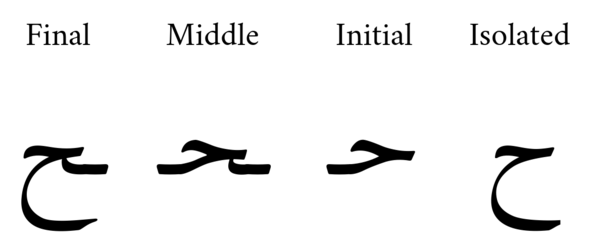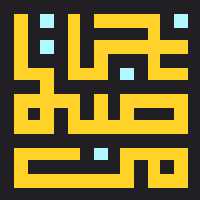Foundations
Arabic writing is famous as an art form, stunning even to those who can’t read it. Writing the Quran beautifully is an act of worship in Islam—Allah is beautiful and loves beauty1
But before diving into any advanced topic, we must start with the basics: Arabic is written from right to left! Moreover, Arabic letters are always written in a ‘cursive’ style. This means letters in the same word connect to each other (with systematic exceptions).
Depending on these connections, the shape of each letter changes. This helps optimize text to make reading and writing easy, but it can be a big challenge for new students. Every letter in Arabic has rules for when written isolated, or at one of three possible positions in a single word: the beginning, middle and end.
Take a look:

All four of the shapes above are the same Arabic letter Hā. Depending on the connections that come before or after it in the word, the shape of the letter changes.
This can be shocking at first glance. But there are features of the letter that are always present to make things much easier. In the figure above we see that:
- the final and isolated forms are identical—one connection from the right is the only difference,
- the initial and middle forms only remove the long curved stroke from the bottom-half,
- every form of this letter has the top, “head” part of the letter
While a bit hard to learn at first, the different letter forms make writing by hand much more enjoyable. Also, many other languages also have variant writings for the same letter. English has a system of capital letters, some of which have no similarity to their alternate case!
Furthermore, Arabic re-uses many letter forms for different letters, separating them only by ‘dots.’ Meaning just 18 different letter forms represent the 28 different letters of Arabic. This reduces the effort of learning, reading and writing Arabic.
For example, the figure below has three different letters of the alphabet. They look exactly the same except for the dots:
 Arabic letters Jīm, Hā and Khā
Arabic letters Jīm, Hā and Khā
Art
Based on this detailed web of rules, of which we have barely scratched the surface, comes art.
Creativity in general flourishes when facing restrictions. Likewise,the field of Arabic calligraphy challenges all the detailed rules of writing. The gold standard is to break rules visually while still obeying them technically. This is art that turns beautiful words meanings into pure visual beauty:
 Calligraphy: “Lord, forgive me”
Calligraphy: “Lord, forgive me”
The above is one style and application of Arabic calligraphy. Although art is creative expression, much of Arabic calligraphy is as much a science as an art. Years of long training are required to learn strokes that were invented and perfected by past masters.2
But some types allow more artistic freedom. There are many other styles and variations that have developed over 1000+ years in different areas of the Islamic world. One famous style makes the figure of an animal or other figure using words. Another style of calligraphy looks like a language from another world:
 Square Kūfī: “Who is silent is saved”
Square Kūfī: “Who is silent is saved”
The example above is the square variation of Kūfī calligraphy. This is the simplest form of Arabic writing that shows a different kind of creativity. These blocky letters are a staple of Islamic architecture, perfect for wall tiles and geometric patterns.
There are amazing regional variations too. Haji Noor Deen, a Chinese Arabic-calligrapher, blends both those writing styles. See his amazing bismilla hirrahmā nirrahīm:3

This brings to mind the reality of Islam—pure water that fits in the container of different world cultures, without any compromise to the substance. Architecture, dress and food are more examples of this.
This article is part of the Introduction to Arabic series: a fresh exploration of the language for people at all levels.
The Messenger of Allah, peace and blessings be upon him, said, “Verily, Allah is beautiful and he loves beauty. He loves the loftiest of affairs and disapproves of pettiness.” Source: al-Mu’jam al-Awsaṭ 6902, via Daily Hadith Online ↩︎
A fantastic series on Arabic calligraphy by Joumana Medlej on Tutsplus ↩︎
“China Meets Arabia: The Calligraphy Of The Orient” from Bahath.co ↩︎